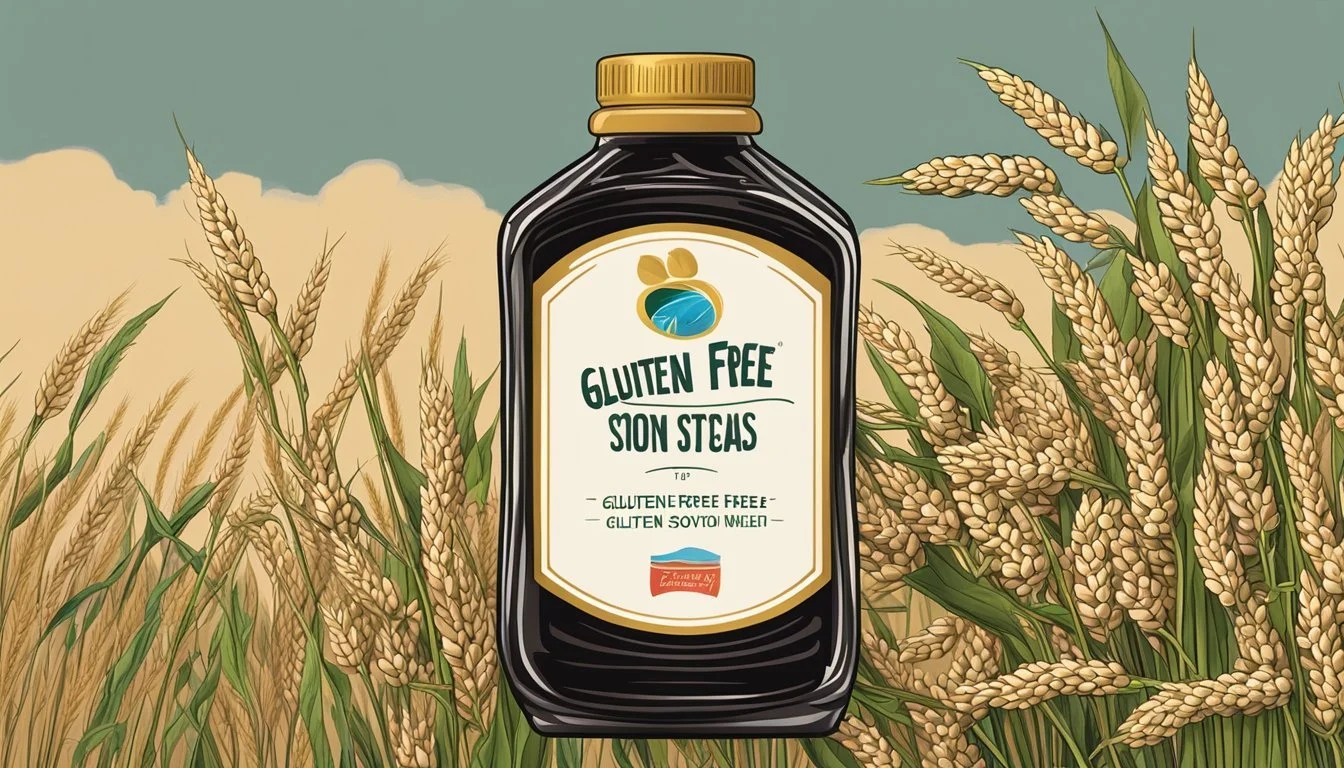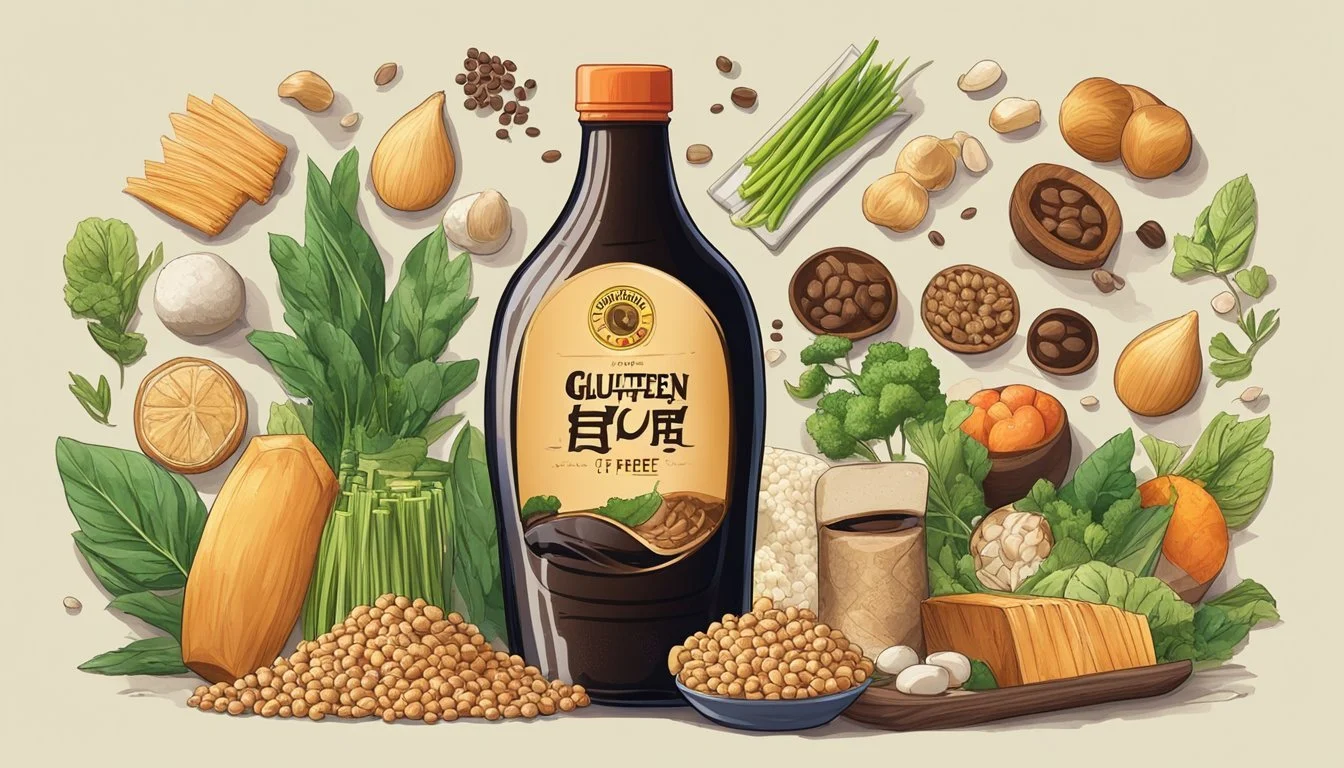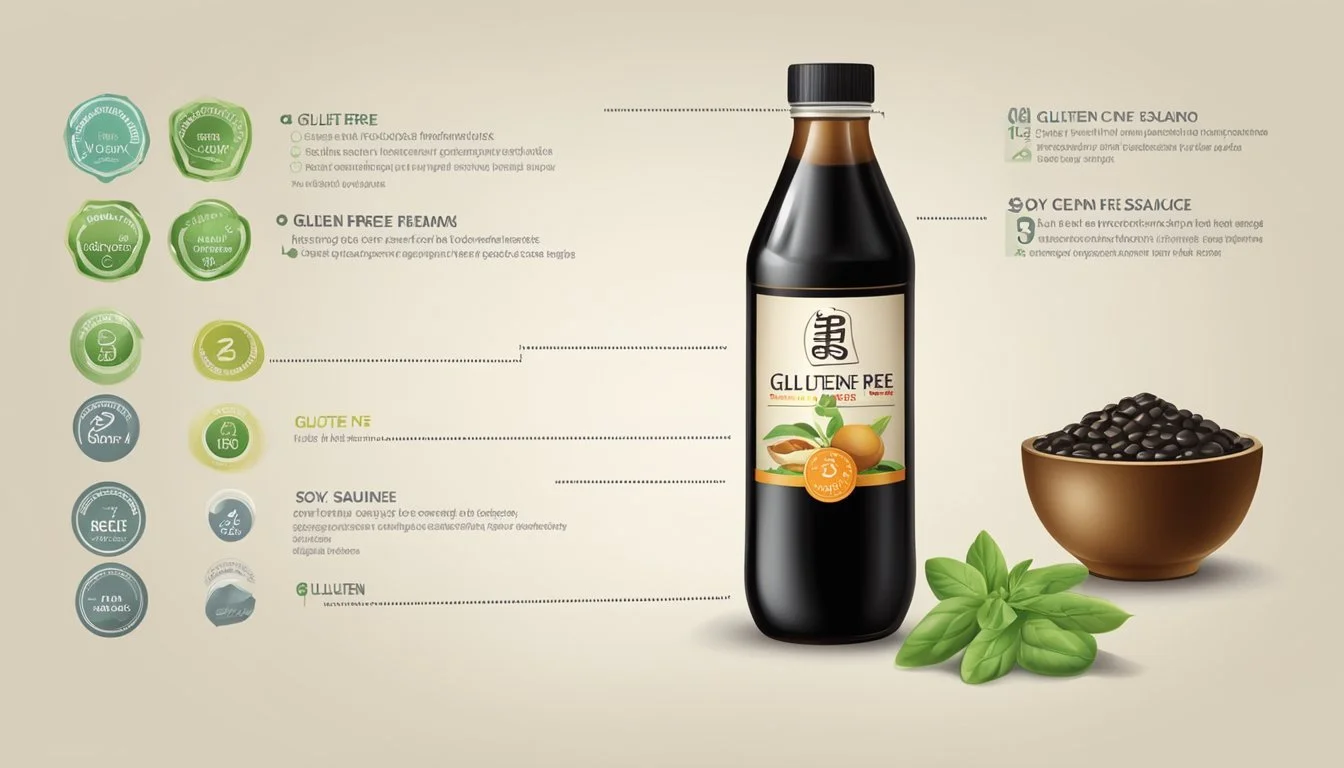Is Soy Sauce Gluten-Free?
Unveiling the Truth Behind Its Ingredients
Soy sauce is a staple of Asian cuisine, widely enjoyed for its rich, umami flavor. This dark, aromatic condiment is traditionally made through fermenting soybeans with wheat, water, and salt, a process that produces its distinctive taste. However, this traditional method introduces gluten into the soy sauce, which poses a significant concern for individuals with celiac disease or gluten sensitivity. Gluten is a protein found in wheat, barley, rye, and triticale, and it must be avoided in a gluten-free diet to prevent adverse health effects.
As awareness of gluten-related health issues has increased, demand for gluten-free products has followed suit, prompting manufacturers to produce alternative versions of soy sauce that cater to this dietary requirement. Gluten-free soy sauces are typically made by substituting wheat with rice or other gluten-free grains, or by using only soybeans and water. The result is a product that maintains a flavor similar to traditional soy sauce while being safe for those who need to avoid gluten.
Consumers seeking gluten-free soy sauce should check labels carefully, as not all soy sauce products are gluten-free. Even products labeled as 'gluten-free' can vary in gluten content, depending on the manufacturing process and standards followed. For the most rigorous dietary needs, sauces that have been independently verified to contain less than 20 parts per million (ppm) of gluten are considered safe for gluten-free diets according to many health organizations. This level is the threshold that many health authorities use to define gluten-free products. Given the potential health implications, it is essential for consumers to be discerning when choosing a soy sauce to ensure that it aligns with their dietary restrictions.
Understanding Gluten
Gluten is a protein composite that one primarily finds in grains such as wheat, barley, and rye. It is renowned for its elastic properties, which impart chewiness and help dough rise and maintain its shape. Gluten can be problematic for certain individuals, notably those with celiac disease or gluten intolerance.
Celiac disease is an autoimmune disorder where the ingestion of gluten leads to damage in the small intestine. Those diagnosed with this disease must adhere to a strict gluten-free diet to avoid symptoms and intestinal damage.
An individual with gluten intolerance, also known as non-celiac gluten sensitivity (NCGS), may experience symptoms similar to those of celiac disease, such as abdominal pain and bloating, but without the accompanying intestinal damage. The management of NCGS typically involves a gluten-free diet to alleviate symptoms, although it may not need to be as strict as for celiac disease.
Choosing a gluten-free diet requires careful consideration of ingredients in culinary products. Here's a simple breakdown of terms to aid in understanding and selection:
Gluten-containing grains: wheat, barley, rye
Common gluten-free grains: rice, corn, quinoa, buckwheat
Gluten-free certification: denotes products tested and confirmed to be free of gluten
For products such as soy sauce, it's essential to inspect labels as they may contain gluten unless explicitly stated otherwise. Alternatives like tamari can be gluten-free, provided they are made without wheat. Always look for the gluten-free label to ensure safety for those with celiac disease or gluten intolerance.
Basics of Soy Sauce
Soy sauce is an essential condiment with a rich history in Asian cuisine, particularly within Japanese tradition. It's produced through a process called fermentation, which involves the breakdown of raw materials by microorganisms. The primary ingredients in traditional soy sauce are soybeans, wheat, salt, and water. In the fermentation process, these ingredients are combined and left to brew, allowing the development of soy sauce's unique flavor, color, and aroma.
Ingredient Role in Soy Sauce Soybeans Provide protein and deep umami flavor. Wheat Adds sweetness and fullness to the flavor profile. Salt Acts as a preservative and flavor enhancer.
During fermentation, the proteins from soybeans are broken down into amino acids, contributing to the umami taste—recognized as one of the five core tastes alongside sweet, sour, bitter, and salty. The presence of wheat not only influences flavor but also its consistency and texture.
While soy sauce is traditionally fermented, modern practices have led to the development of non-fermented alternatives, which may differ in taste and nutritional profile. It is important for consumers to be aware that traditional soy sauce contains wheat and, as a result, gluten—a protein composite found in grains like wheat, barley, and rye. However, due to dietary restrictions and increasing demand, gluten-free soy sauces have been developed.
Gluten-free soy sauces substitute wheat with other grains or use only soybeans, salt, and water, ensuring that the final product is safe for those with celiac disease or gluten sensitivity. These varieties, such as Tamari, often boast a richer, less salty flavor profile and are preferred by many seeking gluten-free options.
Gluten in Soy Sauce
Traditional soy sauce contains gluten, as it is a byproduct of fermenting soybeans with roasted wheat. Gluten, a group of proteins present in wheat, poses a risk for individuals with celiac disease or gluten intolerance.
Composition of Regular Soy Sauce
Wheat: An essential ingredient in standard soy sauce, contributing to its unique taste and fermenting process. Soybeans: The primary component of soy sauce, paired with wheat during fermentation. Gluten Content: Present due to wheat, making regular soy sauce unsuitable for a gluten-free diet.
People seeking a gluten-free alternative often opt for products labeled as gluten-free soy sauce. These alternatives replace wheat with other grains that do not contain gluten or may completely omit grains from the recipe.
Gluten-Free Soy Sauce Options
Tamari: A Japanese sauce, typically richer in flavor with little to no wheat, thus a lower gluten content.
Certified Gluten-Free alternatives: Various brands offer products validated by a gluten-free certification.
To avoid gluten, consumers should read labels carefully for a gluten-free claim. Tamari-style sauces are often gluten-free, but it is still crucial to confirm with product labeling. Gluten-free soy sauces cater to dietary restrictions while still providing the savory flavor associated with traditional soy sauce.
Exploring Gluten-Free Soy Sauce
Gluten-free soy sauce offers a range of alternatives for those with gluten intolerance or celiac disease. Gluten-free tamari is a popular choice, produced mainly from soybeans with little to no wheat, offering a flavor profile similar to traditional soy sauce. Brands like Kikkoman and San-J provide gluten-free tamari options that are widely recognized for their quality and authenticity.
Kikkoman Gluten-Free Soy Sauce is a versatile option for cooking, seasoning, and dipping. It's characterized by its rich and less salty taste compared to regular soy sauces. Being both gluten-free and non-GMO, Kikkoman caters to a health-conscious audience. Similarly, San-J Tamari Gluten-Free Soy Sauce ensures that those avoiding gluten don't have to compromise on taste. It's designed to bring a balanced, savory flavor to dishes without the inclusion of wheat.
Another alternative is coconut aminos, a sauce made from the sap of coconut trees. It mimics the flavor of soy sauce but is naturally soy-free and gluten-free, making it suitable for those on stricter dietary regimes due to allergies or health choices.
When choosing a gluten-free soy sauce, it's essential to read labels carefully. Look for terms indicating the absence of gluten-containing ingredients:
Gluten-Free: Indicates the product does not contain gluten.
Wheat-Free: Shows that no wheat has been used, although other gluten-containing grains may be present.
Here is a succinct view of gluten-free options:
Brand Type Properties Kikkoman Gluten-Free Soy Sauce Non-GMO, Vegan San-J Tamari Gluten-Free Non-GMO Coconut Secret Coconut Aminos Organic, Soy-Free
Consumers seeking gluten-free options will find that these sauces retain the essence of traditional soy sauce while providing a safe alternative to include in their cuisine.
Soy Sauce Alternatives
When considering a switch from traditional soy sauce due to gluten intolerance, allergy concerns, or celiac disease, it's important to explore alternatives that offer similar flavors. Gluten-free alternatives to soy sauce are readily available and can be used in a variety of dishes without sacrificing taste.
Tamari
Tamari soy sauce stands out as the closest substitute to traditional soy sauce. It offers a similar rich, umami flavor but is typically made without wheat, making it a gluten-free option. Gluten-free tamari is preferred by those with celiac disease or gluten sensitivity, as it provides the desired flavor profile without the gluten.
Coconut Aminos
Coconut aminos are a soy-free and gluten-free substitute derived from the sap of coconut trees. This sauce is lower in sodium than traditional soy sauce and has a slightly sweeter taste. It's a suitable option for those on a gluten-free diet or for anyone looking to avoid soy due to allergies.
Other Substitutes
There are additional gluten-free soy sauce substitutes one may consider:
Liquid aminos: Made from non-fermented soybeans, it is a gluten-free but not soy-free option.
Maggi seasoning: Available in a gluten-free formula, be sure to check the label.
Fish sauce: While having a distinct flavor, it can be used in small amounts.
Homemade Options
Creating a homemade soy sauce substitute gives one full control over the ingredients, ensuring a gluten-free outcome. A basic recipe might include:
Boil a broth with ingredients such as garlic, ginger, and onions.
Incorporate flavors like dried mushrooms or seaweed for an authentic taste.
Add vinegar, molasses, and a pinch of salt to achieve a depth similar to soy sauce.
These ingredients can be adjusted to match personal dietary requirements and taste preferences, providing a safe and savory alternative for those avoiding gluten.
Brands and Manufacturers
When navigating the world of soy sauces, customers who have gluten sensitivities or celiac disease should consider certain brands that offer gluten-free options. Leading manufacturers have responded to the demand for gluten-free soy sauces by offering specialized products that are safe for this segment of consumers.
Kikkoman: A widely recognized soy sauce brand, Kikkoman produces several gluten-free varieties. Their tamari-style soy sauce lists water, soybeans, rice, and salt as ingredients, ensuring no wheat content. They also have other options such as a reduced sodium sauce and a premium tamari sauce with water, salt, soybeans, and sugar.
San-J: San-J is notable for their selection of certified gluten-free and non-GMO soy sauces, which includes traditional Tamari, Organic Tamari, and varieties with lowered sodium content. Their products are also vegan and Kosher, catering to a wide range of dietary needs.
Lee Kum Kee: Also providing gluten-free soy sauce options, Lee Kum Kee caters to those looking for an authentic taste without the presence of gluten.
La Choy: An American brand known for its Asian-style sauces, La Choy offers soy sauce that is labeled as gluten-free, providing an alternative to traditional soy sauce.
Table: Comparison of Gluten-Free Product Offerings
Brand Organic Option Non-GMO Varieties Available Kikkoman No Yes Tamari, Reduced Sodium San-J Yes Yes Tamari, Reduced Sodium Lee Kum Kee No Unclear Standard Gluten-Free Soy Sauce La Choy No Unclear Standard Gluten-Free Soy Sauce
It's important to note that while some brands may offer gluten-free products, always check the label for certification and ingredients to ensure the product meets individual dietary requirements.
Labeling and Regulations
When it comes to understanding whether soy sauce is gluten-free, one must refer to the regulations set by the Food and Drug Administration (FDA). The FDA's guidelines stipulate that for a product to be labeled as "gluten-free", it must contain less than 20 parts per million (ppm) of gluten. This criterion is crucial for the safety of individuals with celiac disease or gluten sensitivity.
Specific to fermented or hydrolyzed foods, which include soy sauce, the FDA issued a final rule that came into effect in August 2020. This rule outlines the conditions under which these products can carry a "gluten-free" claim on their labeling. For instance:
A product that starts with gluten-containing grains can be labeled "gluten-free" if the grains are processed to remove gluten and the end product contains less than 20 ppm of gluten.
However, certain products, such as a soy sauce made from wheat, may not be labeled as "gluten-free" due to their manufacturing process and final gluten content.
It is crucial for consumers to read the ingredients label carefully. A product that is "certified gluten-free" has undergone additional verification and testing by third-party organizations, ensuring compliance with strict gluten-free standards.
Consumers should look for:
Certified Gluten-Free logos indicating third-party certification.
Ingredients labels that confirm the absence of wheat, barley, rye, or their derivatives.
By adhering to FDA regulations and scrutinizing product labels, individuals can make informed choices about the presence of gluten in soy sauce and other food products.
Health and Dietary Considerations
When considering the dietary implications of soy sauce, one should be aware that traditional soy sauce contains gluten, a protein found in wheat, barley, and rye. This poses a significant concern for individuals adhering to a gluten-free diet, particularly those with celiac disease—an autoimmune disorder where gluten triggers harmful immune responses. Additionally, people with a wheat allergy or gluten intolerance should avoid products containing gluten to prevent adverse reactions.
There are soy sauce alternatives that cater to gluten-free requirements, notably gluten-free tamari. Tamari is traditionally made with minimal wheat, and many varieties are fully gluten-free, thus suitable for those with sensitivities:
Gluten-Free Tamari: Often made solely from soybeans, water, and salt, and is a safer option for a gluten-free diet.
Gluten-Containing Soy Sauces: Typically include wheat as a primary ingredient.
Consumers should consistently look for "gluten-free" labels on packaging to ensure safety. Soy protein, which is a component of soy sauce, is generally regarded as safe for those with gluten-related disorders, provided it is not contaminated with gluten.
For those requiring strict adherence to a gluten-free diet, the vigilance in checking the ingredient lists and certification labels on soy sauce is critical. The Food and Drug Administration (FDA) mandates that products labeled "gluten-free" must contain less than 20 parts per million (ppm) of gluten. This level is considered safe for most people with celiac disease.
In summary, persons with gluten-related disorders should exercise caution with soy sauce and opt for verified gluten-free tamari to ensure their health and dietary needs are met without risk of exposure to gluten.
Cooking and Usage
In the realm of Asian cuisine, soy sauce is an indispensable ingredient. It's prized for its rich umami flavor, which adds depth and complexity to dishes. When cooking with soy sauce, it's important to consider its potent taste. A small amount can significantly impact the flavor profile of foods, ranging from marinades to sauces and stir-fries.
For those requiring a gluten-free diet, the ingredient list on traditional soy sauce bottles can be problematic, as it typically includes wheat. Therefore, individuals should seek out tamari soy sauce, which generally doesn't contain gluten, or certified gluten-free soy sauce alternatives.
Below is a list of common uses of soy sauce in cooking:
Marinades: Enhances the taste of meats and vegetables prior to cooking.
Stir-fries: Adds a savory element to a quick and high-heat dish.
Sauces: Forms the base for many dipping and cooking sauces.
Seasoning: Provides a finishing touch to dishes to enrich flavor.
When substituting traditional soy sauces with gluten-free options, chefs should consider the flavor intensity, as it can vary among brands. The use of tamari may offer a slightly different taste profile, with a focus on umami, and can often be a little less salty. Gluten-free options are readily available and should be clearly labeled to ensure they meet the required dietary needs.
In summary, gluten-free soy sauces offer a safe alternative for enhancing the flavor of foods without compromising on taste, particularly in the preparation of Asian-inspired dishes. Chefs and home cooks alike should meticulously check labels to safeguard their cuisine meets the requirements of a gluten-free diet.
Shopping Guide
When looking for gluten-free soy sauce, shoppers have several reliable options. They can choose from various brands that are known for their certified gluten-free products. San-J Tamari Gluten-Free Soy Sauce is widely available and comes in several varieties, including organic and reduced sodium options, catering to those watching their salt intake or preferring organic products.
Kikkoman Tamari Soy Sauce is another popular choice that boasts certification for being gluten-free. It is crafted with water, rice, salt, and soybeans, void of wheat ingredients. This brand also offers a low sodium version and an organic option, and these products can be found at mainstream retailers such as Walmart and Whole Foods.
For those looking for convenient single-serving options, Kari-Out offers soy sauce packets, which are a handy choice for gluten-free individuals on the go. These may not be as widely available as the bottled products but can often be found in various food service establishments.
When shopping online, customers can use platforms like Amazon to purchase gluten-free soy sauce brands like La Choy Gluten-Free Soy Sauce and Ohsawa Tamari Soy Sauce, both of which are designed for those who avoid gluten, with Ohsawa offering an organic non-GMO product.
Remember to always check product labels for certifications to ensure the soy sauce meets gluten-free standards. Many retailers, including Whole Foods and Walmart, maintain sections dedicated to gluten-free products, making it easier for consumers to spot the right options.
Brand Organic Option Non-GMO Certified Gluten-Free Available at San-J Tamari Yes Yes Yes Walmart, Whole Foods Kikkoman Tamari Yes No Yes Walmart, Whole Foods La Choy No No Yes Amazon, Walmart Ohsawa Tamari Yes Yes Yes Amazon Kari-Out Packets No No Not always Food Service
FAQs about Soy Sauce and Gluten
Is traditional soy sauce gluten-free?
No, traditional soy sauce typically contains gluten, as it is made by fermenting soybeans with roasted wheat.
What are the implications for individuals with celiac disease consuming soy sauce?
Individuals with celiac disease must avoid traditional soy sauce due to its gluten content, which can trigger harmful reactions. They should focus on gluten-free alternatives instead.
Are there gluten-free soy sauce options available?
Yes, there are gluten-free versions of soy sauce available, such as tamari, which is often made without wheat, and certain brands that specifically produce gluten-free soy sauce.
Can someone with a wheat allergy or sensitivity consume traditional soy sauce?
No, those with a wheat allergy or sensitivity should also avoid traditional soy sauce as it contains wheat. They must look for wheat-free soy sauce alternatives.
What are some alternatives to soy sauce for those on a gluten-free diet?
Tamari: A wheat-free version of soy sauce, often with a similar flavor profile.
Coconut Aminos: A soy-free and gluten-free option with a slightly sweeter taste.
How can one ensure they are choosing a gluten-free soy sauce?
Individuals must read the product labels carefully, looking for terms like "gluten-free" or verifying that the ingredients do not include wheat or any other sources of gluten.
Conclusion
Soy sauce traditionally contains gluten due to wheat being a key ingredient in the fermentation process. For individuals requiring a gluten-free diet, such as those with celiac disease, consuming regular soy sauce can pose a health risk.
Gluten-Free Options:
Tamari: Often made without wheat, but one should verify through labels.
Gluten-Free Soy Sauce: Formulated with alternatives like rice or corn.
Alternative Condiments: Liquid aminos or coconut aminos serve as substitutes.
It's crucial for consumers seeking gluten-free products to examine food labels carefully. The FDA mandates clear labeling for gluten-free products, which must contain less than 20 parts per million of gluten.
Label Check List:
"Gluten-Free" certification or similar wording.
Absence of wheat, barley, rye, or crossbred hybrids in ingredients.
Verification of potential cross-contamination in facilities.
In conclusion, people with gluten sensitivities must exercise caution and opt for specifically labeled gluten-free soy sauce products to avoid gluten intake.








